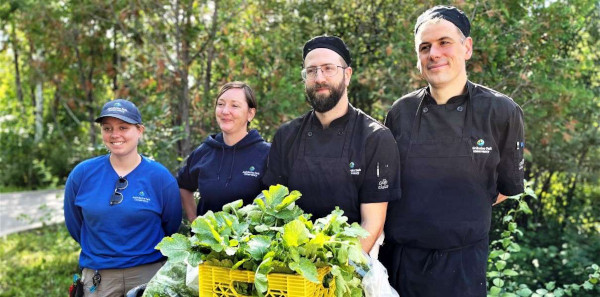The slow movement
Cultural shift picks up speed
A cultural shift is slowly working its way into society. Promoting connection to people, community, oneself and food, followers of the slow movement advocate for a deliberate and unhurried way of life.
The start of this movement is credited to Carlo Petrini, a journalist from Rome. In 1986, Petrini joined protesters who objected to the opening of a McDonald’s restaurant in the heart of their city.
The Italians handed out bowls of pasta to passersby while shouting, “We don’t want fast food. We want slow food.”
Thus was created the slow food movement, which morphed into a subculture. Eventually, the slow slogan was applied to other spheres of life and activities, including the concepts of slow cities, slow travel and slow living.
The idea is not new. It is a reversion to a less hurried, pre-industrial time. The technological age has revved up the speed at which people and communities do things.
Canadian journalist Carl Honoré is a proponent of slow living and its related movements. (Supplied photo)
In a TED talk, Honoré refers to modern “Road Runner culture” as a world addicted to speed. “When we want to make things better, we speed them up. We used to dial, now we speed dial. We used to walk, now we speed walk. We used to read, now we speed read. We used to date, now we speed date,” he says.
Downshifting in life, slow-movement followers take the time to enjoy simple pleasures: tasting the texture of food and connecting to people and places. The slowed-down attitude is less preoccupied with moving fast and with the unnecessary. Generally, when people move through life quickly, they feel less emotion and are more superficial.
Citizens living in the world’s longest-living cultures, called Blue Zones, espouse the same way of life as slow-movement adherents.
Healthy, older citizens in Blue Zone countries take the time to eat a home-grown, vegetarian-based diet, sleep well and build and maintain lifelong connections.
Some have engineered slow as an acronym for Sustainable, Local, Organic and Whole.
It may not be applicable to all aspects of the slow lifestyle, but it definitely pertains to the slow-food movement.
Slow food
Although protesters were not successful in stopping the mammoth McDonald’s food chain from setting up shop in Rome, their slow-food movement caught on.
Three years later, Petrini signed a slowfood manifesto in Paris that was considered a rebuffing, a rejection of the fast life.
Followers of the slow-food movement encourage connection between people while partaking in the preparation and eating of healthy food. It is not about eating in order to live but relishing all the joys associated with the breaking of bread with another or in community.
Closer to home, the concept is burgeoning. The Kitchen Garden at The Leaf in Assiniboine Park is home to a variety of vegetables, fruits, herbs and other edible plants. Assiniboine Park spokesperson Laura Cabak says “The design of the Kitchen Garden was meant to connect visitors to where our food comes from and how it’s grown.”
The Farmer’s Kitchen (FK) is a grocery store situated in The Village, a new development at Pineridge Hollow. The Village website refers to FK as passionate about providing high-quality, nutrient-dense food, moving away from the McDonald’s-like style of fast food.
Slow cities
“What sets Winnipeg apart is its wide-open spaces that offer nature inside city limits.” - Tyler Walsh, Tourism Winnipeg. (Supplied photo)_(1)feature_1100_733_90.jpg)
Cittaslow believes that the slower pace of life is conducive to a better quality of life. It stands up for less traffic, less noise and general well-being.
Cittaslow leads a global slow-city movement. In fact, it is more than a movement, since the organization holds the power to assess whether other towns or cities meet the criteria to be considered a slow city.
The group expanded beyond Italy, and the first slow city in the English speaking world is Ludlow, England. Today, Cittaslow is an international network of towns and cities.
A Canadian city was the first North American city to be officially deemed a slow community. Cowichan Bay in British Columbia received the designation in 2014.
In 2019, the city was in danger of losing their coveted label. It appears fewer businesses were involved, and the feeling of community was being lost. However, they are still listed on Cittaslow’s directory of slow cities.
Currently, four Canadian cities hold the official slow-city designation. The others are Lac-Megantic in Quebec, Naramata in the Okanagan and Wolfville in Nova Scotia.
Slow Canadian cities have their own Cittaslow network complete with a website and newsletter.
When The Uniter reached out to the Canadian branch of Cittaslow for comment before deadline, they replied “We don’t like to do things fast.”
Slow travel/tourism
“The design of the Kitchen Garden was meant to connect visitors to where our food comes from and how it’s grown.” - Laura Cabak, Assiniboine Park. (Supplied photo)
Some people feel the need for a vacation after taking a vacation. Slowing down a bit can help people truly rest, relax and return home restored and recharged.
The simpler, more connected way of life has penetrated into the travel industry, including locally.
Tyler Walsh, spokesperson for Tourism Winnipeg, says “As one of Canada’s best-kept secrets, Winnipeg is the perfect destination for slow travellers. What sets Winnipeg apart is its wide-open spaces that offer nature inside city limits like FortWhyte Alive with its urban bison herd and plentiful walking trails, as well as the upcoming Leaf at the Diversity Gardens, which will house four worlds under one biome at Assiniboine Park.”
Increasingly, travellers stay away from tourist traps or destination choices based on crossing off an item from their bucket list.
It’s about disconnecting from devices and savouring the moment. It is taking the path less trodden, meandering down that path, exploring its nooks and corners along the way. It is travelling more deeply, making a connection to a locale and its surroundings.
This approach to travel is more economical and environmentally friendly, as one journeys at their own pace. Instead of hopping on a train or a plane every three days, slow travellers stay in place, immersing themselves in the culture.
Slow tourism is the sustainable aspect of travel, also referred to as eco-tourism. Increasingly, travellers opt for modes of travel and destinations that minimize harm to the environment.
By “living” rather than staying at a travel destination, people experience a locale more intimately. A genuine connection to surroundings can create an emotional impact.
This approach can be applied to local travel. Taking the time to explore during a day trip or afternoon outing can help someone experience travel more deeply.
One of the best ways to slow travel is to use slow transportation. Nature enthusiasts ditch the speedboat and opt for kayaks and canoes, appreciating the sights and sounds of wildlife on shore and in the sky. Cycling or renting a bike is also an excellent way to experience the journey en route.
Slow living
Slow travel emphasizes quality time in locations, even local ones, rather than long distances and busy itineraries. (Photo by Daniel Crump)
Busyness is sometimes described as nothing but misplaced priorities. Followers of slow living believe busyness is a choice. Why not enjoy the entire day, not just a portion of it, by connecting to the moment fully?
Employees have recently popularized “quiet quitting,” which is basically the refusal to work after hours without pay. The work masses are saying no to employers who keep employees metaphorically chained to work desks or connected to work devices. Employees are expected to keep toiling past quitting time and are not allowed to punch the clock.
Employees (and possibly many employers, too) want a better work-life balance and insist on prioritizing life over work.
A general awakening is occurring. Proponents expound on living mindfully with a focused purpose.
More information about the Farmer’s Kitchen can be found at thefarmerskitchengrocery.com. The gardens at Assiniboine Park, including the Kitchen Garden, can be found at The Leaf or online at bit.ly/3qW2PoU. For more information on slow communities, visit slowfood.com, cittaslow.org, slowmoney.org and slowmovement.com.
Published in Volume 77, Number 03 of The Uniter (September 22, 2022)






